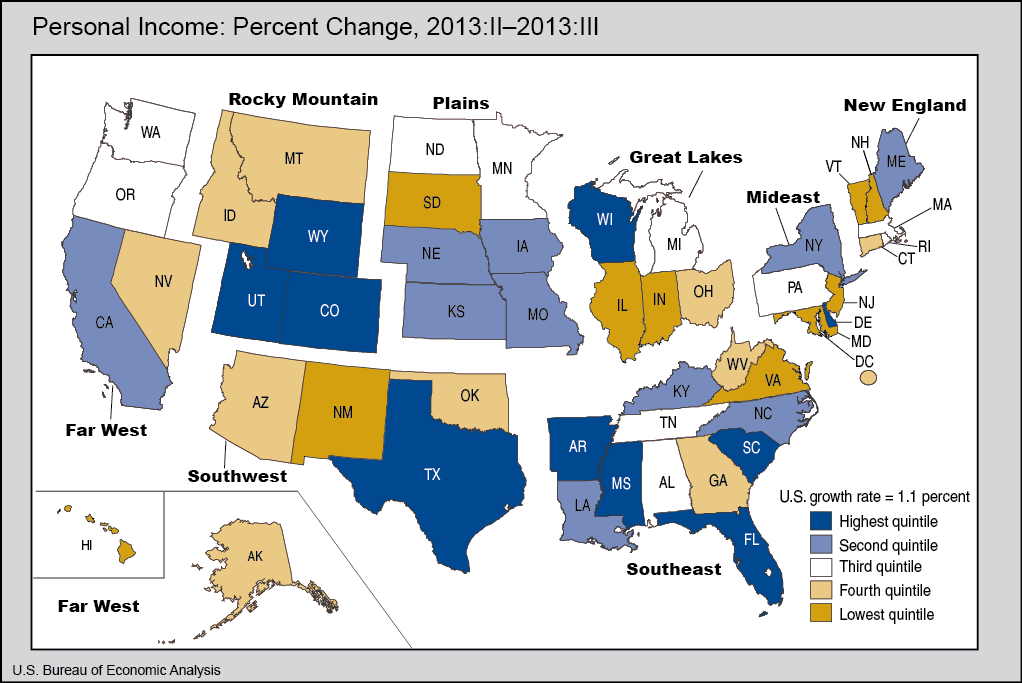News Release
State Quarterly Personal Income, 1st quarter 2013-3rd quarter 2013
State personal income growth slowed slightly to 1.1 percent in the third quarter of 2013, from 1.2 percent in the second quarter, according to estimates released today by the U.S. Bureau of Economic Analysis. Growth slowed in 25 states, accelerated in 22, and was unchanged in 3 states and the District of Columbia. Growth across states ranged from 0.4 percent in New Mexico to 1.9 percent in Mississippi. The national price index for personal consumption expenditures increased 0.5 percent in the third quarter after remaining unchanged in the second quarter.
Slightly more than half of the personal income increase in Mississippi—$1.0 billion—was a current transfer receipt representing a settlement for a class-action suit that alleged racial discrimination by the U.S. Department of Agriculture in its evaluation of farm loan applicants between 1981 and 1996. Farm operators in Alabama received slightly less than $1.0 billion while farmers elsewhere received the balance of the $3.4 billion national settlement.
Earnings by state and industry. Overall, earnings grew 0.7 percent in the third quarter of 2013, down from 1.0 percent in the second quarter. Earnings grew in every private-sector industry but the earnings of civilian federal employees fell 2.6 percent. Earnings grew in every state but earnings in the District of Columbia fell 0.3 percent.
The largest contributions to earnings growth in the third quarter were in construction (which increased $7.6 billion), finance (up $7.4 billion), and professional services (also up $7.4 billion). In contrast, civilian federal earnings declined $7.8 billion.
The third-quarter decline in civilian federal earnings was the largest of seven consecutive quarterly declines. It included a reduction of $5.0 billion due to furloughs that affected primarily the civilian employees of the Department of Defense. The fall in civilian federal earnings reduced personal income growth by 0.2 percentage point in Maryland and Hawaii and 0.3 percentage point in Virginia. The 0.6 percent personal income growth in these three states exceeded only New Mexicos 0.4 percent growth.
Property income. Property income grew 1.9 percent in the third quarter of 2013, the net effect of a 3.6 percent gain in dividends, a 2.1 percent gain in rent, and a 0.7 percent rise in interest income. In the second quarter property income grew 2.8 percent. The rate of property income growth in the third quarter exceeded personal income growth, which made its contribution to percent change in personal income larger in Wyoming and Florida, where property income represents a large share of personal income.
Revisions. Estimates for 2013:I and 2013:II have been revised. All of the quarterly state personal income statistics, along with mapping and charting software, are available in a set of interactive data tables at /iTable/iTableHtml.cfm?reqid=70&step=1&isuri=1&acrdn=3.
Definitions
Personal income is the income received by all persons from all sources. Personal income is the sum of net earnings by place of residence, property income, and personal current transfer receipts. Property income is rental income of persons, personal dividend income, and personal interest income. Net earnings is earnings by place of work (the sum of wages and salaries, supplements to wages and salaries, and proprietors income) less contributions for government social insurance, plus an adjustment to convert earnings by place of work to a place-of-residence basis. Personal income is measured before the deduction of personal income taxes and other personal taxes and is reported in current dollars (no adjustment is made for price changes).
The estimate of personal income in the United States is derived as the sum of the state estimates and the estimate for the District of Columbia; it differs from the estimate of personal income in the national income and product accounts (NIPAs) because of differences in coverage, in the methodologies used to prepare the estimates, and in the timing of the availability of source data.
BEA groups all 50 states and the District of Columbia into eight distinct regions for purposes of data collecting and analyses: New England (Connecticut, Maine, Massachusetts, New Hampshire, Rhode Island, and Vermont); Mideast (Delaware, District of Columbia, Maryland, New Jersey, New York, and Pennsylvania); Great Lakes (Illinois, Indiana, Michigan, Ohio, and Wisconsin); Plains (Iowa, Kansas, Minnesota, Missouri, Nebraska, North Dakota, and South Dakota); Southeast (Alabama, Arkansas, Florida, Georgia, Kentucky, Louisiana, Mississippi, North Carolina, South Carolina, Tennessee, Virginia, and West Virginia); Southwest (Arizona, New Mexico, Oklahoma, and Texas); Rocky Mountain (Colorado, Idaho, Montana, Utah, and Wyoming); and Far West (Alaska, California, Hawaii, Nevada, Oregon, and Washington).
State personal income statistics provide a framework for analyzing current economic conditions in each state and can serve as a basis for decision making. For example:
- Federal government agencies use the statistics as a basis for allocating funds and determining matching grants to states. The statistics are also used in forecasting models to project energy and water use.
- State governments use the statistics to project tax revenues and the need for public services.
- Academic regional economists use the statistics for applied research.
- Businesses, trade associations, and labor organizations use the statistics for market research.
BEA's national, international, regional, and industry estimates; the Survey of Current Business; and BEA news releases are available without charge on BEA's Web site at www.bea.gov. By visiting the site, you can also subscribe to receive free e-mail summaries of BEA releases and announcements.
****
Next state personal income release – March 25, 2014, at 8:30 A.M. for state personal income, fourth quarter 2013 and preliminary annual 2013.
